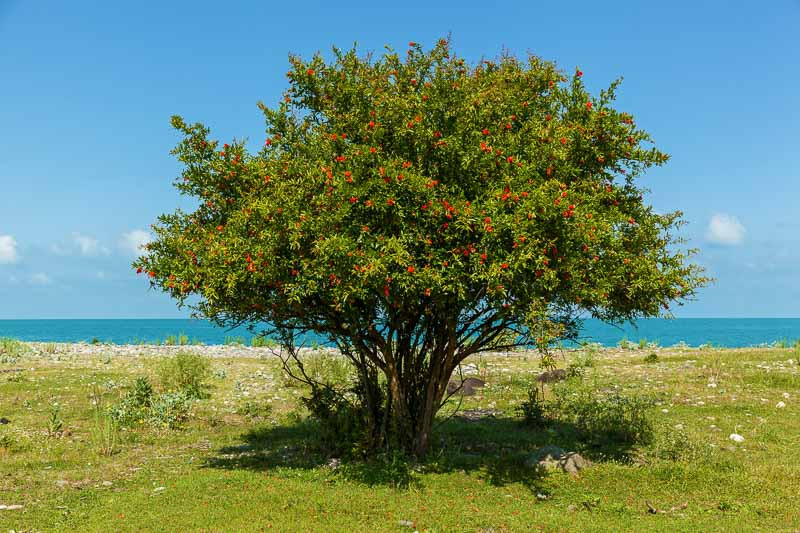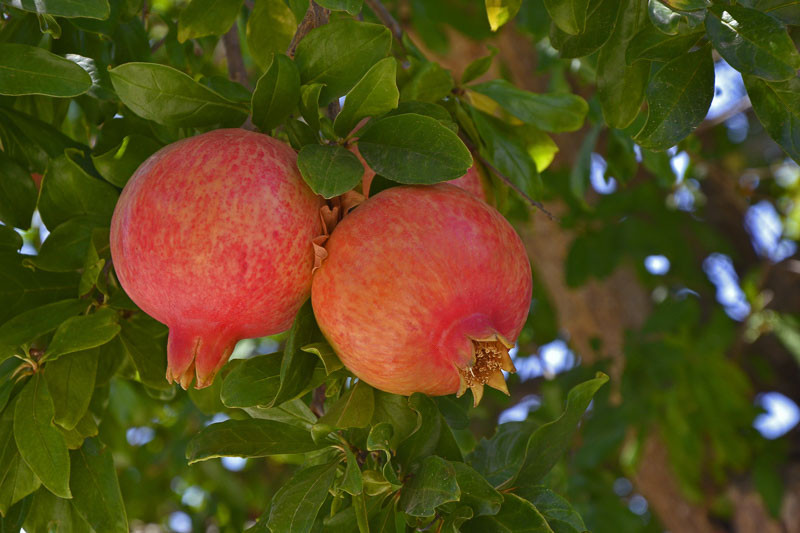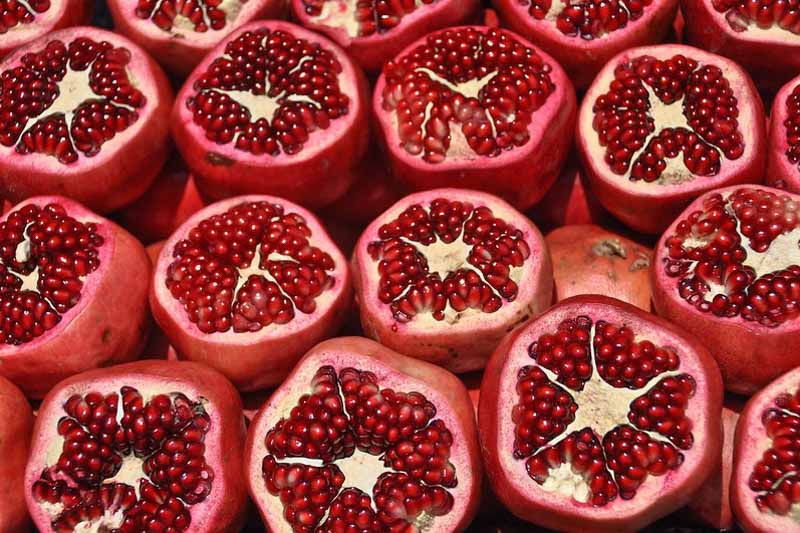Pomegranate, Carthaginian Apple, Granada
The pomegranate tree (Punica granatum) is a veritable feast for the eyes and palate, prize for its vibrant red-orange flowers and luscious, jewel-like fruit. A handsome shrub in flower and worthy of inclusion in the border.
Native: Originally native to regions of the Middle East and Central Asia, the pomegranate has been cultivated for millennia and has spread to various parts of the world, including the Americas and Europe.
Plant Type and Habit: Punica granatum is a deciduous or semi-evergreen small tree or large shrub with a multi-stemmed, upright, and spreading habit. It can be pruned to maintain a desired shape or allowed to grow freely.
Size: Typically, pomegranate trees range from 6 to 20 feet (1.8 to 6 meters) in height and 4 to 15 feet (1.2 to 4.5 meters) in spread, although dwarf varieties are available that grow to about 4 feet (1.2 meters) tall.
Flowers: The pomegranate produces striking, funnel-shaped, crepe paper, bright scarlet flowers, 2 inches (5 cm) in diameter. They are borne singly or in clusters at the branch tips.
Bloom Time: Blossoms appear from late spring to early summer, with some varieties producing sporadic blooms throughout the growing season.
Fruit: Shining against the foliage, the flamboyant flowers are followed by spherical, reddish-brown, leathery-skinned fruits up to 4 inches across (10 cm). They can be eaten fresh or used in jams or jellies. Pomegranate is partially self-fertile, so planting two or more varieties increases the fruit set.
Foliage: Its numerous slender branches are clothed with lustrous, narrowly oblong, rich green leaves that emerge bronze in spring. They provide an attractive backdrop for the colorful fruit and flowers. Evergreen in warm winter areas, the foliage changes to soft yellow-green, sometimes brilliant yellow, in the fall.
Hardiness: Pomegranate trees are hardy in USDA zones 7-10, although they appreciate some protection from harsh winter winds in the cooler end of this range.
Uses: Beyond fruit production, pomegranate trees are versatile in the landscape. They can serve as specimen trees, hedge plants, or foundation plants and are great in Mediterranean-style gardens. Pomegranates can also be grown in large pots or containers, making them suitable for small spaces or colder climates where they can be brought indoors. They’re also popular choices for bonsai.
Wildlife: Birds are attracted to the fruit, and pollinators like bees or hummingbirds are drawn to the flowers. However, the spiny branches generally deter larger herbivores.
Deer and Rabbits: While not completely resistant, the spiny nature of many pomegranate varieties tends to make them less appealing to deer and rabbits.
Toxicity: Pomegranate trees are generally considered non-toxic to humans and pets, although excessive consumption of the fruit’s seeds can be problematic due to their high caloric content.
Drought: Pomegranates are remarkably drought-tolerant once established, thanks to their deep root system. However, they do better with consistent moisture, especially when fruiting.
Invasiveness: Pomegranate trees are not considered invasive in most areas, although they can self-seed under the right conditions. Proper pruning can prevent unwanted spread.
Benefits: Beyond their ornamental value, pomegranates are celebrated for their antioxidant-rich fruit, associated with various health benefits. The fruit can be consumed fresh or used in juice, jams, and culinary dishes. The flowers and bark also have traditional medicinal uses.

Yes, pomegranates are highly nutritious and offer a variety of health benefits, both in fruit and juice form. Here are some of the key health benefits of pomegranates:
It’s worth noting that while pomegranates offer a range of health benefits, they are also high in sugar and calories, so moderation is key. Always consult a healthcare provider before making significant changes to your diet, especially if you have existing health conditions or are taking medication.

Eating a pomegranate can be a rewarding but somewhat messy experience if you’re not familiar with the proper technique. Here are some steps on how to eat a pomegranate:

Growing and caring for pomegranate trees can be a rewarding experience, as these plants not only provide beautiful flowers and foliage but also yield delicious and nutritious fruit. Here are some guidelines to help you successfully grow and care for pomegranate trees:
By adhering to these guidelines, you can enjoy the multiple benefits of pomegranate trees, from their stunning flowers to their antioxidant-rich fruit.

Propagation of pomegranate trees can be achieved through various methods, including seed, cuttings, and layering.
Remember to always use sterilized tools to minimize the risk of transmitting diseases to the plant. Propagating pomegranates can be a rewarding way to expand your garden or share this wonderful plant with friends and family.
| Hardiness |
7 - 10 |
|---|---|
| Heat Zones |
1 - 12 |
| Climate Zones | 5, 6, 7, 8, 9, 10, 11, 12, 13, 14, 15, 16, 17, 18, 19, 20, 21, 22, 23, 24, H1, H2 |
| Plant Type | Fruits, Shrubs |
| Plant Family | Lythraceae |
| Genus | Punica |
| Common names | Pomegranate |
| Exposure | Full Sun |
| Season of Interest |
Spring (Late) Summer (Early) Fall |
| Height |
6' - 20' (180cm - 6.1m) |
| Spread |
4' - 15' (120cm - 4.6m) |
| Maintenance | Average |
| Water Needs | Low, Average |
| Soil Type | Chalk, Loam, Sand |
| Soil pH | Acid, Alkaline, Neutral |
| Soil Drainage | Well-Drained |
| Characteristics | Showy, Fruit & Berries |
| Tolerance | Drought |
| Attracts | Birds, Bees, Hummingbirds |
| Garden Uses | Beds And Borders, Hedges And Screens, Patio And Containers, Wall-Side Borders |
| Garden Styles | Mediterranean Garden, City and Courtyard |
| Hardiness |
7 - 10 |
|---|---|
| Heat Zones |
1 - 12 |
| Climate Zones | 5, 6, 7, 8, 9, 10, 11, 12, 13, 14, 15, 16, 17, 18, 19, 20, 21, 22, 23, 24, H1, H2 |
| Plant Type | Fruits, Shrubs |
| Plant Family | Lythraceae |
| Genus | Punica |
| Common names | Pomegranate |
| Exposure | Full Sun |
| Season of Interest |
Spring (Late) Summer (Early) Fall |
| Height |
6' - 20' (180cm - 6.1m) |
| Spread |
4' - 15' (120cm - 4.6m) |
| Maintenance | Average |
| Water Needs | Low, Average |
| Soil Type | Chalk, Loam, Sand |
| Soil pH | Acid, Alkaline, Neutral |
| Soil Drainage | Well-Drained |
| Characteristics | Showy, Fruit & Berries |
| Tolerance | Drought |
| Attracts | Birds, Bees, Hummingbirds |
| Garden Uses | Beds And Borders, Hedges And Screens, Patio And Containers, Wall-Side Borders |
| Garden Styles | Mediterranean Garden, City and Courtyard |
How many Punica granatum (Pomegranate) do I need for my garden?
| Plant | Quantity | |
|---|---|---|
| Punica granatum (Pomegranate) | N/A | Buy Plants |
Create a membership account to save your garden designs and to view them on any device.
Becoming a contributing member of Gardenia is easy and can be done in just a few minutes. If you provide us with your name, email address and the payment of a modest $25 annual membership fee, you will become a full member, enabling you to design and save up to 25 of your garden design ideas.
Join now and start creating your dream garden!
Create a membership account to save your garden designs and to view them on any device.
Becoming a contributing member of Gardenia is easy and can be done in just a few minutes. If you provide us with your name, email address and the payment of a modest $25 annual membership fee, you will become a full member, enabling you to design and save up to 25 of your garden design ideas.
Join now and start creating your dream garden!